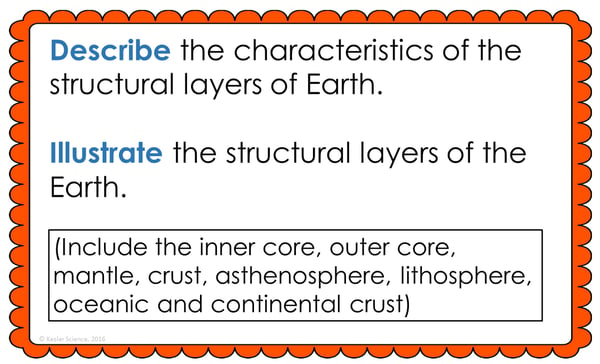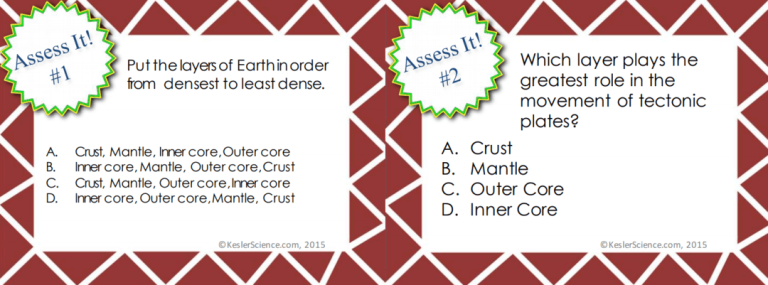Earth's Layers Lesson Plan - A Complete Science Lesson Using the 5E Method of Instruction
By the end of this lesson about the Earth’s layers, students will be able to describe and illustrate the characteristics of the structural layers of Earth. Each of our lessons is designed using the 5E method of instruction to ensure maximum comprehension by the students. This well-thought out unit does the heavy lifting, giving teachers easy-to-implement, highly engaging lesson plans.
This blog will walk you through each of the steps and activities from the Earth’s Layers 5E Lesson Plan.
ENGAGEMENT
Objective Introduction
At the beginning of the lesson, the class will do a Think-Pair-Share to discuss the objective.
Class Activity
- Ask students what prior knowledge they have about the Earth’s Layers.
- Write words on the board as they describe what they already know.
Student Activity
- Students will watch a video from the link provided.
- Match some of the things they already know about the Earth’s crust with what the video presents.
- Tell them they will be going more in-depth with the study of the Earth’s layers.

The teacher will then help to clear up any misconceptions their students have about the Earth’s Layers. A common but major misconception, for example, is that students think are that we have explored all the layers of the Earth already and the center of the Earth is magma.
Estimated Class Time for the Engagement: 20-30 minutes
EXPLORATION
With nine stations in total, you can introduce the Earth's layers to your middle school students in a variety of ways! Four of these stations are considered input stations where students will learn new information about the Earth's layers, and four of the stations are output stations where students will be demonstrating their mastery of the lesson's material. A bonus station offers challenges for your early finishers and independent learners. You can read more about how I set up the station labs here.
Watch It!
At this station, students will be watching a short video explaining why the Earth has layers. Students will then answer some questions relating to the video and record their answers on their lab station sheet. For example: How far have humans been able to drill into the Earth? What scientific principle causes the different layers of the Earth? Which elements are found in the inner core? Solid or Liquid?
Read It?
This station will provide students with a one-page reading about the layers of the Earth. In the reading, students will learn how the Earth is made up of various layers. Each layer having its own density. Students will also find out how scientists have enough evidence to state that the inner core of our planet is solid, even if we have never been there. There are four follow-up questions that the students will answer to demonstrate their comprehension of the reading material.
Explore It!
Students will be working in pairs to better understand how the Earth is made up of many different layers. Each task card contains information about the layers and has the students answer a question based on observations and inferencing. Students will be using this model to make observations and to answer related questions listed on the task cards.
Research It!
The research station will allow students to find out information about Earth’s Layers. Students will be able to click on each layer of the Earth and listen to a brief detailed description of each layer. Students will also be able to answer a few questions based on what they learned.
Organize It!
The Organize It station allows your students to organize key vocabulary terms with the correct descriptions. This will allow the teacher to see if the students understand terms relating to earthquakes.
Illustrate It!
Your visual students will love this station. Students will sketch and label the diagram of the Earth and its layers.
Write It!
Students who can answer open-ended questions about the lab truly understand the concepts that are being taught. At this station, the students will be answering three task cards: Why does the Earth have different layers? List the layers of the Earth and provide a short description of each layer starting with the center of the Earth. How is density related to the layers of the Earth?
Assess It!
The Assess It station is where students will go to prove mastery over the concepts they learned in the lab. The questions are set up in a standardized format with multiple choice answers. Some questions include: Put the layers of Earth’s in order from the densest to the least dense. Which layer plays the greatest role in the movement of tectonic plates? Which two elements are mainly found in the inner and outer core? Why is the inner core solid?

Challenge It! - Bonus Station
Early finishers and advanced students will love the extension activities in this station. Four activity choices offer them ways to expand their learning through mini-games and mini-projects.
Estimated Class Time for the Exploration: One or two 45-minute class periods
EXPLANATION
The explanation activities will become much more engaging for your class once they’ve completed the exploration station lab. During the explanation piece of the lesson, the teacher will be clearing up any misconceptions their students may have about the earth's layers with a variety of materials. These materials include on-level and modified versions of the interactive presentation (may be used individually or projected), anchor charts, and paper or digital interactive notebook activities. If you have students that need modified notes, the 5E lessons come equipped to help give every student access to the lesson.
Interactive notebook samples: Above-left is a digital INB activity slide; above-right is an example of the paper INB activities.
The students will also be interacting with their journals using INB templates for Earth’s Layers. Each INB activity is designed to help students compartmentalize information for a greater understanding of the concept. The Earth’s Layers INB templates allow students to focus their notes on the characteristics of each Earth layer.
Estimated Class Time for the Exploration: Two or three 45-minute class periods
ELABORATION
The elaboration section of the 5E method of instruction gives students choices that allow them to prove they’ve mastered the concepts behind the lesson. When students are given a choice, they’re much more enthusiastic and invested in the project than they are when their teachers choose their projects for them. There are a total of nine choices to demonstrate understanding of the Earth's layers. A separate set of choices that offer more teacher support are also available for students that need them. Rubrics guide students to doing their best work and assist in grading.

Estimated Class Time for the Elaboration: Two or three 45-minute class periods (can also be used as an at-home project)
EVALUATION
The final piece of the 5E model is to evaluate student comprehension. Included in every 5E lesson is a homework assignment, assessment, and modified assessment. Research has shown that homework needs to be meaningful and applicable to real-world activities in order to be effective. When possible, I like to give open-ended assessments to truly gauge the student’s comprehension.
Estimated Class Time for the Elaboration: One 45-minute class period
DOWNLOAD THE FULL LESSON NOW
Download Over $100 in FREE Resources
For Middle School Science
Simply create a login below and gain immediate access to a selection of our Kesler Science product line worth $100 - for FREE. There's a full version of every product type! You'll also join tens of thousands of middle school science teachers who receive timely tips and strategies straight to their inbox.







